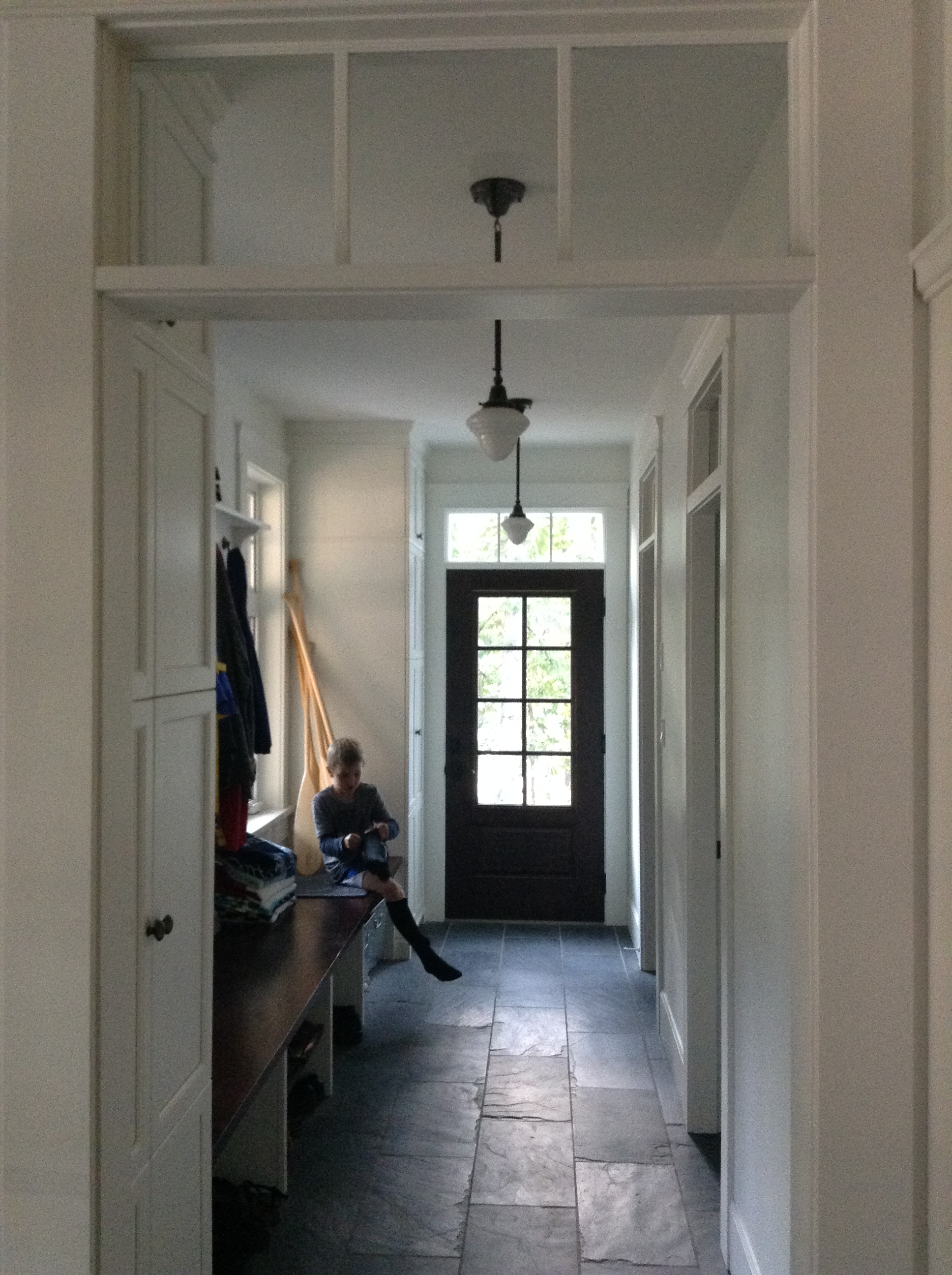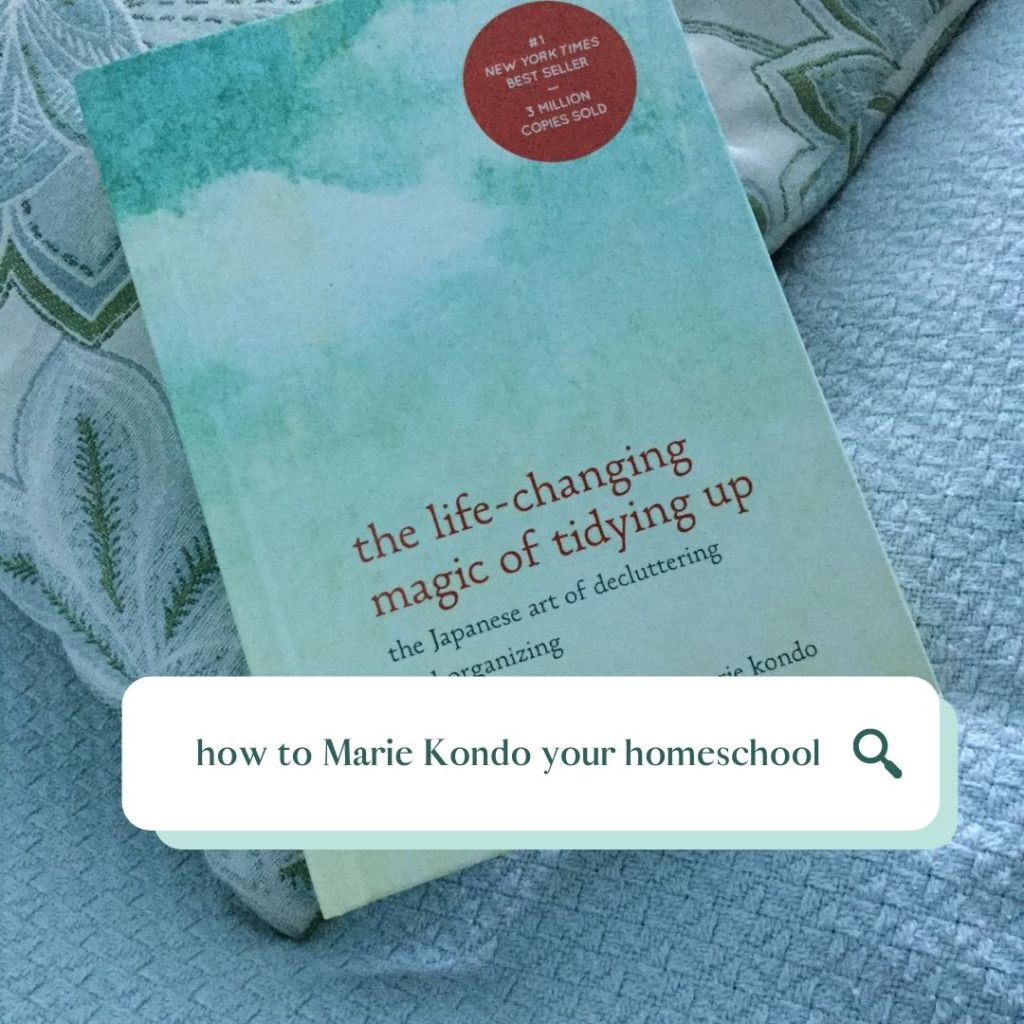Podcast: Play in new window | Download
Perhaps you are one of the 3 million that has purchased the book, “The Life-Changing Magic of Tidying Up: the Japanese Art of Decluttering and Organizing” by Marie Kondo. She’s the samurai of tidy.
We can learn from the samurai warrior of cleaning up. This lady has got tidy going on. And who doesn’t need to Marie Kondo their homeschools?
So how to Marie Kondo your homeschool?
Marie Kondo warns, “The urge to point out someone else’s failure to tidy is usually a sign that you are neglecting to take care of your own space.” So I will simply share what I’ve learned from her book.
I know the experience of how a cluttered house relates to a cluttered mind.
The first thing I do when the hubby takes the kids for the afternoon is tidy, yes, in that rare spare time that I am alone, I tidy for twenty minutes.
I know other homeschool moms will tell me not to: why waste time tidying when you rarely have that alone time?
But tidy house=quiet mind.
And I first need sorta tidy to enjoy my quiet home.
Kondo says we don’t need to tidy when we quietly work away at disposing of our excess continuously. Throw stuff out!
Kondo’s primary principle of tidiness might sound a little too sentimental for my taste, at first, but “take each item in one’s hand and ask: “does this spark joy? If it does, keep it. If not, dispose of it,” is wise.
We’d own very few things with that guidance.
Kondo says we don’t need fancy storage units to get tidy. And I’ll add, we don’t need to increase the share price of Rubbermaid (though I have certainly helped them in the past).
We simply have to not keep everything that passes through our hands and home.
Less is more. Travel has taught me much about being in the moment (and I don’t require more than a backpack of stuff to travel through life). I want my life to be more than just organizing mine and my kids’ stuff. If we love what we own, we can get on with actually living.
Kondo suggests putting every piece of a family member’s personal belongings in one closet.
When we’re heading out the door, I like to know that dirty boots have a home, in the mudroom. That the swim bag has everyone’s suits ready to go, in the mudroom. A canvas bag for my collection of canvas international bags, in the mudroom.
My kids are lucky to have their own rooms, so I keep a basket on the stairs and toss things in there when stray sweaters, socks, Lego, make-up, ponytails…get lost on the main floor.
PS I haven’t always had a mudroom and I know that everyone else doesn’t either. There is always a way to create a stacking basket space right beside the door for the necessities of moving in and out of our homes.

Kondo suggests it is therapeutic, to process our pasts and garbage our childhood memorabilia, but confessional: though I have done that in spades over the years, I just can’t part with certain things from childhood, like my cabbage patch dolls (don’t ask) or my report cards from elementary school. I definitely can’t part with my baby’s memorabilia, and therein lies my excessive Rubbermaid purchases.
What should we do with all that extra stuff found in the recesses of our storage rooms and closets and desk drawers and kitchen drawers? Sell it? Give it away?
I find joy in giving it to someone who values it and I find no joy in hovering over internet sale sites in hopes that I’ll make fifteen bucks. Give it away is my go-to.
I would pay money to visit Kondo’s home. She doesn’t keep papers. What does that mean? NO papers?
She says, no bank statements, no kids’ artwork, no receipts, no warranties, no payslips.
Everything she owns in one closet? I’m in awe.
There’s also a whole lot of work to her approach.
Taking every piece of clothing in the house and laying them on the floor. Six people times two seasons of clothing (spring/summer & fall/winter). The thought of that clothing mountain!
Though I have often heard from others that I don’t own many pieces of clothing, I can’t imagine culling it still. I did take away from Kondo’s book a different way to folding my socks. Yes, sock folding. No stretching the cuffs, just fold them in half on each other like a rectangle. I should have thought of this before.
And old clothes turned loungewear, she is not a fan. (Has she been in my closet?)
I’m a homeschool mom! I don’t want to get rid of a comfortable piece, though it is pilled and not public-worthy, it might not fit me right.
I still keep it and wear it for leisurely homeschool days.
Keep things because you love them, not “just because” someone gave it to you, Kondo advises.
Ooooh, tricky one. Guess that means that when we’re giving others gifts, we might assume that they might not love it as much as we might. Perhaps the original intent behind the gift was that the gift giver cared about us and wanted to give us something.
So we hold that item in our hands, give thanks for the gift that it was, and release it to someone who might love it more.
Every book taken from every bookshelf and laid on the floor? Ummm, I am a homeschool mom.
This book did compel me to sift through the warranties box. What an overlooked box!
I have a six-month-old sofa falling apart, so I was motivated to find the warranty.
But Kondo is right:
- I am never going to reinstall appliances, so why am I keeping installation guides?
- What are the chances that I am going to get warranty work done on a $50 stereo?
- What about those instruction guides to the Toshiba computer I purchased ten years ago?
That box got a whole lot smaller.
There’s not a thing that humanity has owned that Kondo hasn’t discussed chucking, so if you’re interested in a purge of your stuff, this book is your guide.
The criterion for keeping something: “The item has to give you a thrill of pleasure when you touch it”. That’s not a lot of things to keep. But that is a whole lot of holding.

Grappling with Overwhelm Journaling Workbook
Journal questions & workbook that aid in your self-exploration to help address your needs, gain satisfying relationships and shift your homeschool perspective.
This can be a self-coaching workbook can be a self-coaching tool to help you discover the barriers getting in the way of your satisfying homeschool life, create a plan to address your relationships, needs & homeschools, and thereby, shift your homeschool experience.
People also ask:
- How does Homeschooling Affect Families?
- 10 Declutter Tips for Homeschool Moms with Simple by Emmy
- 4 ways essential oils contribute to homeschools with Kristin Mercer
- How to Get Homeschool Mom Community & Connection
- A Meaningful Step-by-Step Guide to Plan your New Homeschool Year
- How do I get a homeschool mama virtual retreat?
(function(m,a,i,l,e,r){ m['MailerLiteObject']=e;function f(){
var c={ a:arguments,q:[]};var r=this.push(c);return "number"!=typeof r?r:f.bind(c.q);}
f.q=f.q||[];m[e]=m[e]||f.bind(f.q);m[e].q=m[e].q||f.q;r=a.createElement(i);
var _=a.getElementsByTagName(i)[0];r.async=1;r.src=l+'?v'+(~~(new Date().getTime()/1000000));
_.parentNode.insertBefore(r,_);})(window, document, 'script', 'https://static.mailerlite.com/js/universal.js', 'ml');
var ml_account = ml('accounts', '1815912', 'p9n9c0c7s5', 'load');



i haven’t read the book because i’m attached to a lot of (not so)stupid stuff, i’ve a big tower of magazines, books, drawings,… even “sentimental” clothing. so i prefer to store it, as long as i live in a big house and i can make it. but does she have kids??? i’m not sure… i imagine her house everything in white-don’t-touch-a-thing.